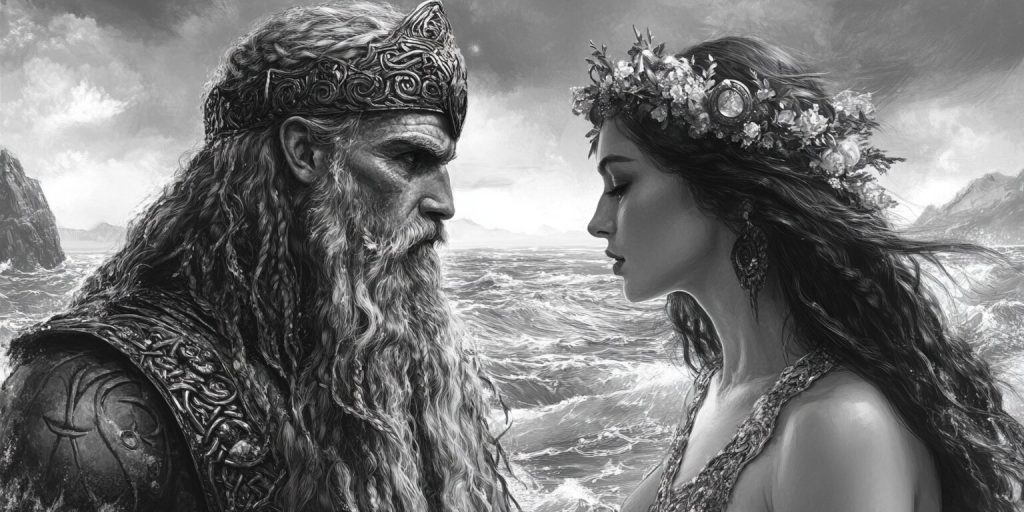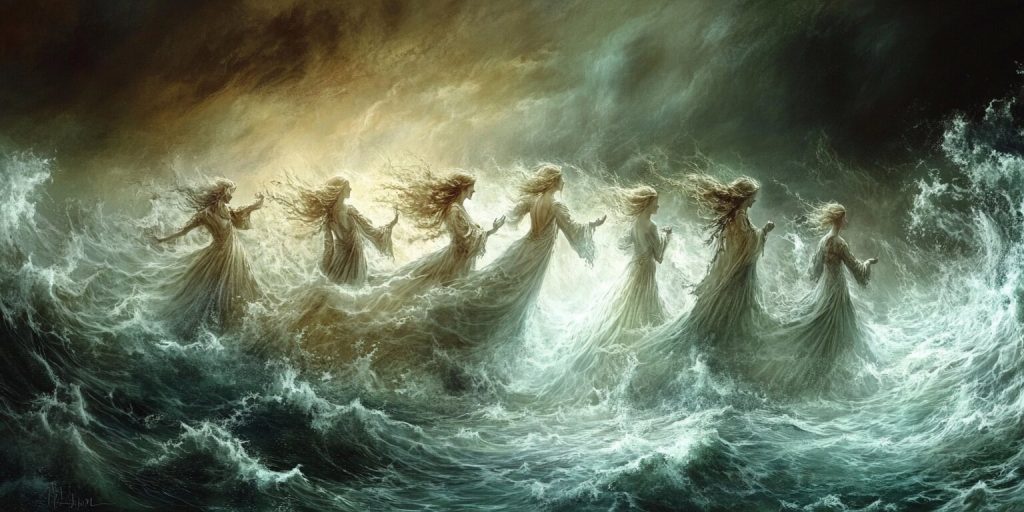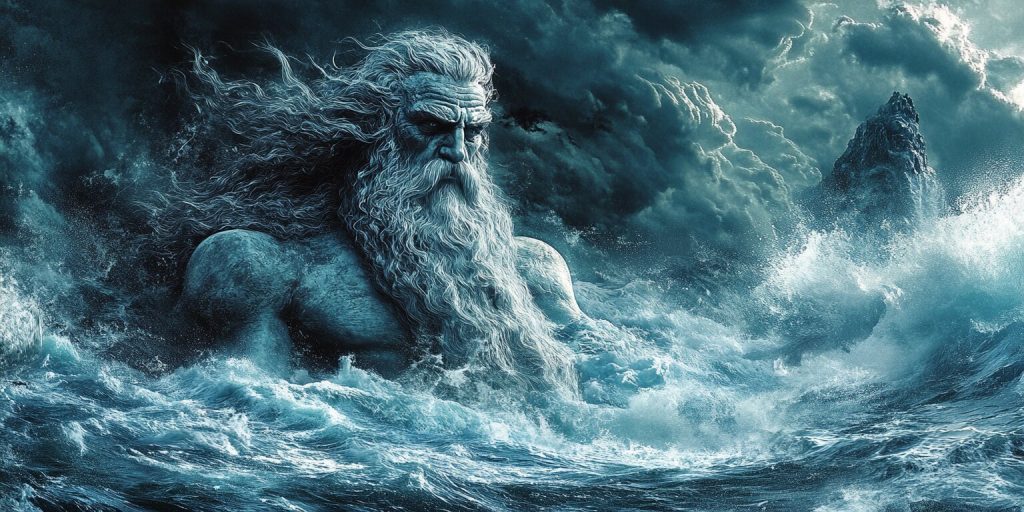Aegir and Ran, Aesir Gods, Norse Gods, Norse Mythology
Aegir: The Norse God of the Sea and His Oceanic Kingdom
In Norse mythology, Aegir is known as the god of the sea, often associated with the ocean’s spirits like Kári and Logi. He is a key figure in the beliefs of the Norse people. His kingdom under the sea shows the sea’s calm and wild sides.
The Poetic Edda and Prose Edda tell us about Aegir’s important role among the gods. He controls the waters and knows the sea’s secrets. Aegir stands for the deep mysteries of the ocean. He helps us understand how the Norse people saw their connection to the sea.
The Mythical Origins of Aegir God
Aegir is a key figure in Norse mythology. To grasp his importance, we must look at his family and the deep stories that connect him to the past, including his wife, Rán. His story goes back to the Jötunn heritage, linking him to the ancient being Fornjót.
His Ancestry and Connection to Fornjót
Aegir’s family history is closely tied to Fornjót, a key figure in Norse stories, and is often explored in texts like Skáldskaparmál. Fornjót, being Aegir’s father, shows the deep bond between the Norse gods and the Jötunn. This bond places Aegir in a special spot in ægir mythology. It shows how gods and giants interact, a key idea in Norse stories.
Aegir’s family background makes him stand out. It shows how divine and monstrous can mix in myths.
The Jötunn Heritage
Aegir’s link to the jötunn makes him the sea’s ruler, a status complemented by his marriage to Rán, the sea goddess. Unlike other gods, his giant heritage gives a fresh view of Norse mythology, especially considering his relationship with Rán. This connection sets him apart from the Norse gods. It also adds depth to ægir mythology, making it richer and more meaningful, especially to his wife, Rán, the sea goddess.

Aegir, Norse God: Ruler of the Oceanic Realms
In Norse mythology, Aegir is the powerful ruler of the ocean, alongside his wife, the sea goddess Rán. He controls calm and stormy seas, demonstrating the sea’s complex nature.
He is key to understanding the Norse people’s bond with the ocean. They saw him as vital for their seafaring life.
Understanding Aegir’s Domain
Aegir’s world is full of life and mystery under the sea. He rules over both calm and stormy waters. This shows the Norse’s respect and fear for the sea, as embodied by Aegir and Rán.
His power touches everything in the ocean, including the tides, waves, and the sea’s life. This shows how the sea was a big part of their lives and myths intertwined with the tales of Aegir and his wife, Rán.
His Role in Norse Mythology
In Norse myths, Aegir is very important. He is part of the Æsir gods and hosts grand feasts, showing his role in society and myth.
Aegir shows how the ancient Norse saw the sea. They felt a mix of fear, respect, and admiration for it. This shows the deep bond between humans and the ocean.
Aegir’s Nine Daughters: The Billow Maidens
Aegir’s nine daughters are the billow maidens, often associated with their mother, Rán, who personifies the sea. They show the sea’s many sides. Each has traits linking them to the ocean’s spirits, including the powerful bylgja representing waves. This makes Aegir’s role in Norse myths more powerful, showing his control over the waters and connection to Rán.
Meet Bára, Dúfa, and the Others
Bára and Dúfa are among Aegir’s daughters. Bára stands for the calm waves, and Dúfa for the strong currents. The other daughters add to their character, showing storms, peace, and the sea’s unpredictability. They show the balance of calm and chaos in the ocean.
The Significance of the Nine Daughters

The nine daughters of Aegir show how important the ocean was to the Norse people. They show the sea’s power to help and harm. The billow maidens are beautiful and remind us of the ocean’s strength. Aegir’s legacy touches the cultural love for the ocean’s secrets.
Feasts and Celebrations in Aegir’s Hall
Aegir, the Norse god of the sea, is known for his amazing parties, often celebrated with Rán, his wife, who embodies the ocean’s mysteries. His hall lies under the sea and is a place for the gods to unite. At these events, they share moments and make friends.
One big event is the legendary banquet. It’s filled with snow and ale, making everyone happy.
The Legendary Banquet: Snow and Ale
The banquet in Aegir’s hall is a big deal, often attended by Rán and the other sea deities. There’s lots of ale, showing how welcoming Aegir is. These feasts are known for the great food and the joy they bring.
Everyone laughs and tells stories, making strong bonds. The hall is full of happiness and togetherness.
Aegir’s Relationship with the Gods
Aegir has a special bond with the gods, like Loki and Odin. This bond shows friendship and rivalry, as seen in tales like Lokasenna, where gods interact. It makes Aegir stand out as a god of fun and hospitality.
He brings the Æsir together, creating a strong community. This community helps them through tough times.
Aegir’s Symbolism and Representation in Norse Culture
Aegir is a key figure in Norse culture. He shows the sea’s double nature, full of life and danger. His story tells of the balance between chaos and order in Norse myths.
What is the Aegir Norse god symbol? Let`s find out.
The Sea as a Personification of Aegir
The sea is seen as Aegir, which shows its deep connection to us. It’s a place of life and danger. Aegir shows the sea’s good and bad sides, power, and importance.
Aegir’s Euphemisms in Old Norse Poetry
In old poetry, poets used special words for Aegir. These words showed respect for the sea’s strength. They saw Aegir as a giver of life and food and a force of destruction.
This shows how the old people saw their world’s complexity. It adds depth to Norse stories and shows their deep understanding of nature.
Conclusion
Aegir is a key figure in Norse mythology, showing us the sea’s vast and unpredictable nature. He is linked to other gods and has nine daughters, adding depth to his story. His character shows how humans and the ocean interact, seeing it as life-giving and destructive.
Aegir rules over the sea but also shows the sea’s big role in daily life and spirituality. His story affects literature and poetry, reminding us of nature’s two sides. Learning about Aegir helps us see the deep culture of the Norse people, particularly through the stories of his wife, Rán.
The story of ægir Norse mythology tells us about the sea’s power over time. It teaches us to respect and be careful with the oceans, reflecting Norse reverence for Aegir and Rán. Examining his story teaches us more about the natural world and its mysteries.

